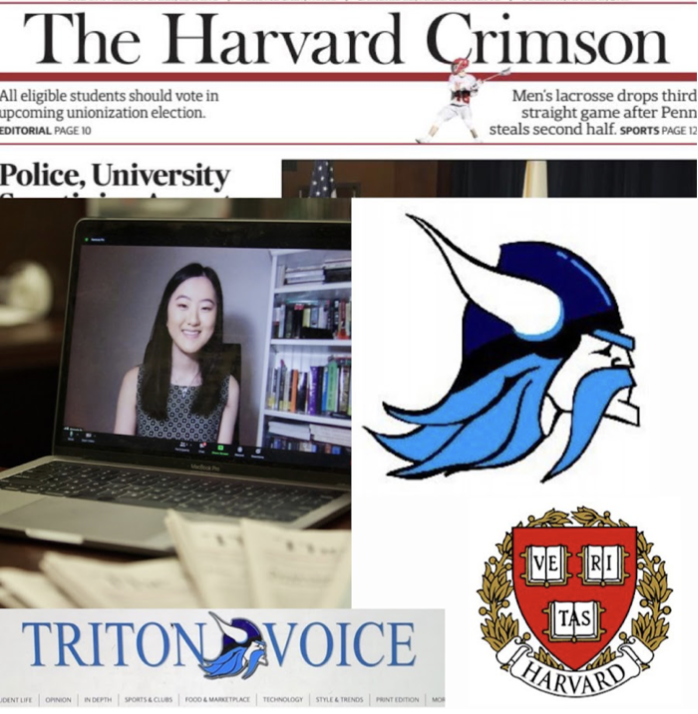The Harvard Crimson vs. the Triton Voice: Are They Really That Different?
Comparing the Similarities and Differences in High School and College Newspapers
The flags of the Harvard Crimson and the Triton Voice with Amanda Su, the President of the Harvard Crimson.
In the heart of Cambridge, Massachusetts, students scattered throughout the world-renowned Harvard University campus sit at tan, wooden desks late into the night, rushing to meet their newspaper’s deadline. While their writing partner snoozes in Radcliffe quad, a mass of eight dorms a few blacks from Harvard Square, their determination to submit by the morning’s 8 a.m. class pulls every ounce of their attention into a 3-year-old Macbook and notebook full of scribbled notes.
This practice of determination and hard work is common at Harvard. With the intelligent, diverse, and driven student body, attendees focus heavily on their ambitious goals, guided and supported by the nearly-unlimited resources provided by the 2,400 professors here. These qualities are reflected in the writers and board of The Harvard Crimson, the University’s breakfast-table daily newspaper.
Thirty-eight miles away in the small suburban town of Byfield, students at Triton Regional High School work towards similar goals, writing and producing an article every two weeks, creating enough content to put out a weekly version of the school’s newspaper, The Triton Voice. James Allen teaches two periods of the journalism class, full of junior and senior staff writers.
A journalist at Triton, Channing Marengi, has been interviewing all week for her newest article about the tricky bathroom situation and problems they have been causing. She expresses her love for the freedom journalism class has provided. “I enjoy being able to express what I want to talk about instead of being given a prompt,” said Marengi. “You’re given the freedom to write about what you’re passionate about… As I’ve gotten into it, I’ve really enjoyed writing articles.”
While writers at Triton like Marengi spend two weeks working on one article, the timeline is set so that every Thursday the Triton Voice is printed, distributed by members of the paper the next morning on Friday. As for the Harvard Crimson, it is the only breakfast-table daily newspaper in Cambridge, Mass. The Crimson publishes every morning, Monday through Friday, except on federal and University holidays. This makes for stricter and sooner deadlines for journalists at Harvard. Established in 1873, there is a rich tradition of journalistic integrity in this newspaper with over 25 Crimson alumni having won the Pulitzer Prize.
The process of creating each paper has several differences and similarities in both the Triton Voice and Harvard Crimson. With proper funding and an endowment of $53 billion, the Crimson undoubtedly has increased access to resources and the ability to print everyday, yet this does not make the Triton Voice less of a notable news source.
A first hand look into the features of the Crimson and what it’s like under the pressure of a wide-spread read newspaper can be seen through Chloe Shawah, a senior at Harvard majoring in statistics. Unfamiliar to the world of journalism, she joined the Crimson as a freshman out of interest, now a chair on the editorial board who loves this environment and calls the Crimson her home. She enjoys being on this board because it is open and inviting and also frequently discusses difficult topics.
While there are several boards on the Crimson, content boards get published daily, including news and editorial. Each board has daily jobs and are all on a different schedule weekly. The editorial prints three pieces everyday, an op-ed, and staff-ed, and a column. The work happens Sunday-Thursday and each and every article is picked to perfection. Chloe is co-chair with Hana Kiros, a senior integrative biology major. With several writers under this board there are lead editors as well.
“Each day our editors work on pieces probably a few days before they get published,” said Shawah. “They are editing, proofing a piece, working with the writer, fact checking, we have a very rigorous fact checking process, and then it gets sent to Han and I the night before. We proof it and we send all three pieces to the president of the Crimson who does a last double check on them.”
This process is similar to that of the Triton Voice’s. While it is not published daily, writers and editors are working each day leading up to publication to proofread every article and make it the best it can be. There are staff writers that go through the articles which then gets read one last time by Allen and then sent to the printing press. With fewer articles, there is less to be done, but still lots of behind the scenes work that is set up like any other newspaper. Not everyone in the Triton Voice is on the exact same schedule which is just like a Harvard writer.
Similar practices can be seen at UMass Amherst. The Daily Collegian is published Monday through Friday and has a process of each article going through an assistant editor, a copy editor, and a night editor before being fully approved and published. Cassie McGrath, a former student and journalist at UMass Amherst. She thoroughly enjoyed her time working at The Daily Collegian and had varying experiences with deadlines and topics to write about.
“Seeing that each article tells a different story, I approached each differently,” said McGrath. “For an investigative piece, we would sometimes take weeks to speak with sources from different perspectives, submit public records requests or pull together data. Other times, we would get press releases from the school or local communities that could go up in minutes.”
McGrath’s passion in reporting for The Daily Collegian led to a career in the business, now a reporter for MassLive. She encourages anyone, whether they have a passion for writing or not, to engage themself in a college or high school newspaper. “I cannot stress enough how fun it is to work for a college paper. I made lifelong friends in the Daily Collegian newsroom so although it was work, it also gave me some of the best college memories.”
While no newspaper is entirely the same, all work towards one goal of publishing content that is informative and varies in ideas. Whether it is a high school newspaper, college newspaper, local newspaper, or national newspaper, the process behind each edition is extensive and multifarious.

Hi! My name is Ellie Gay-Killeen and I’m a senior at Triton High School. I was formally a runner on the high school team from eighth grade to junior...


